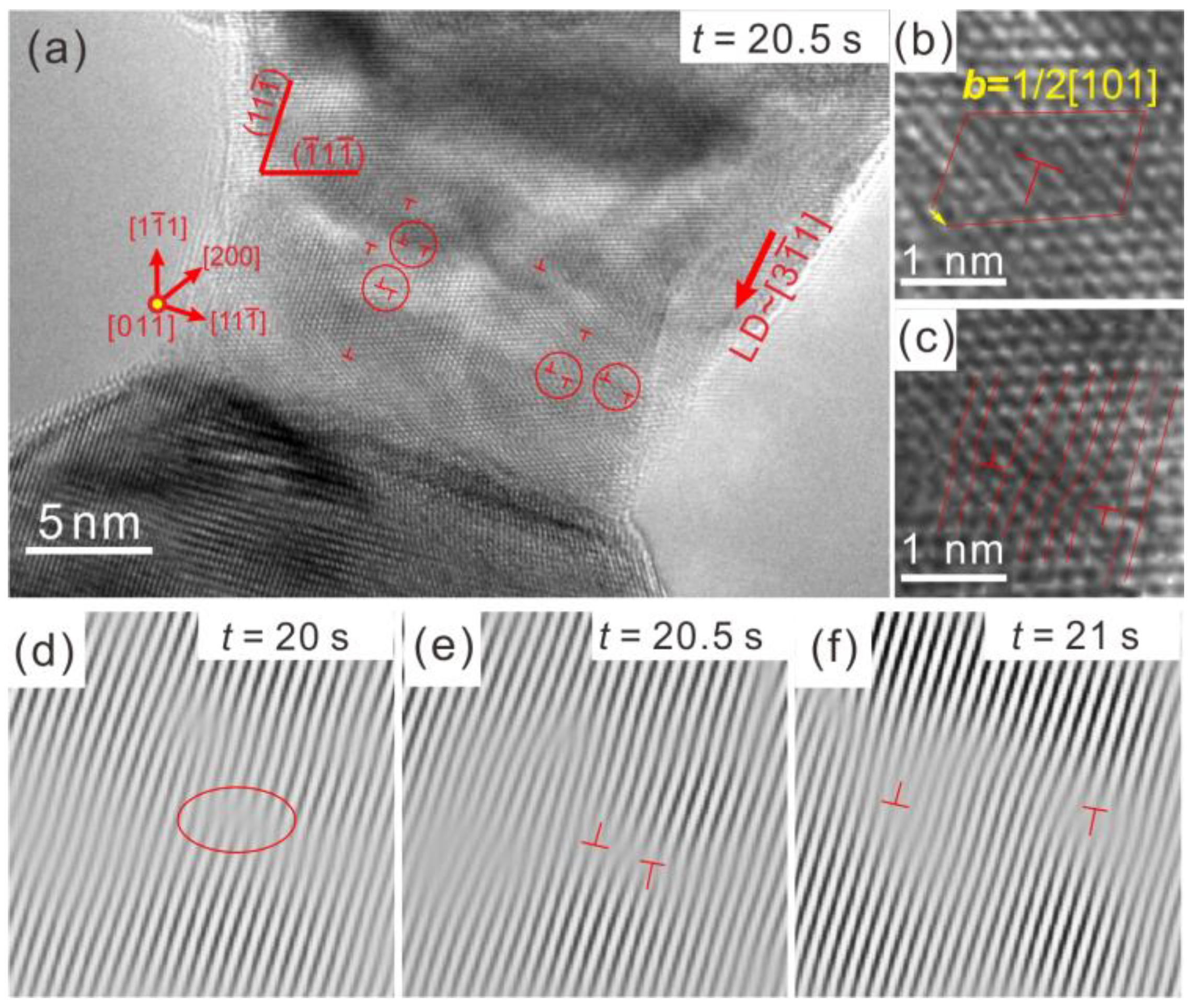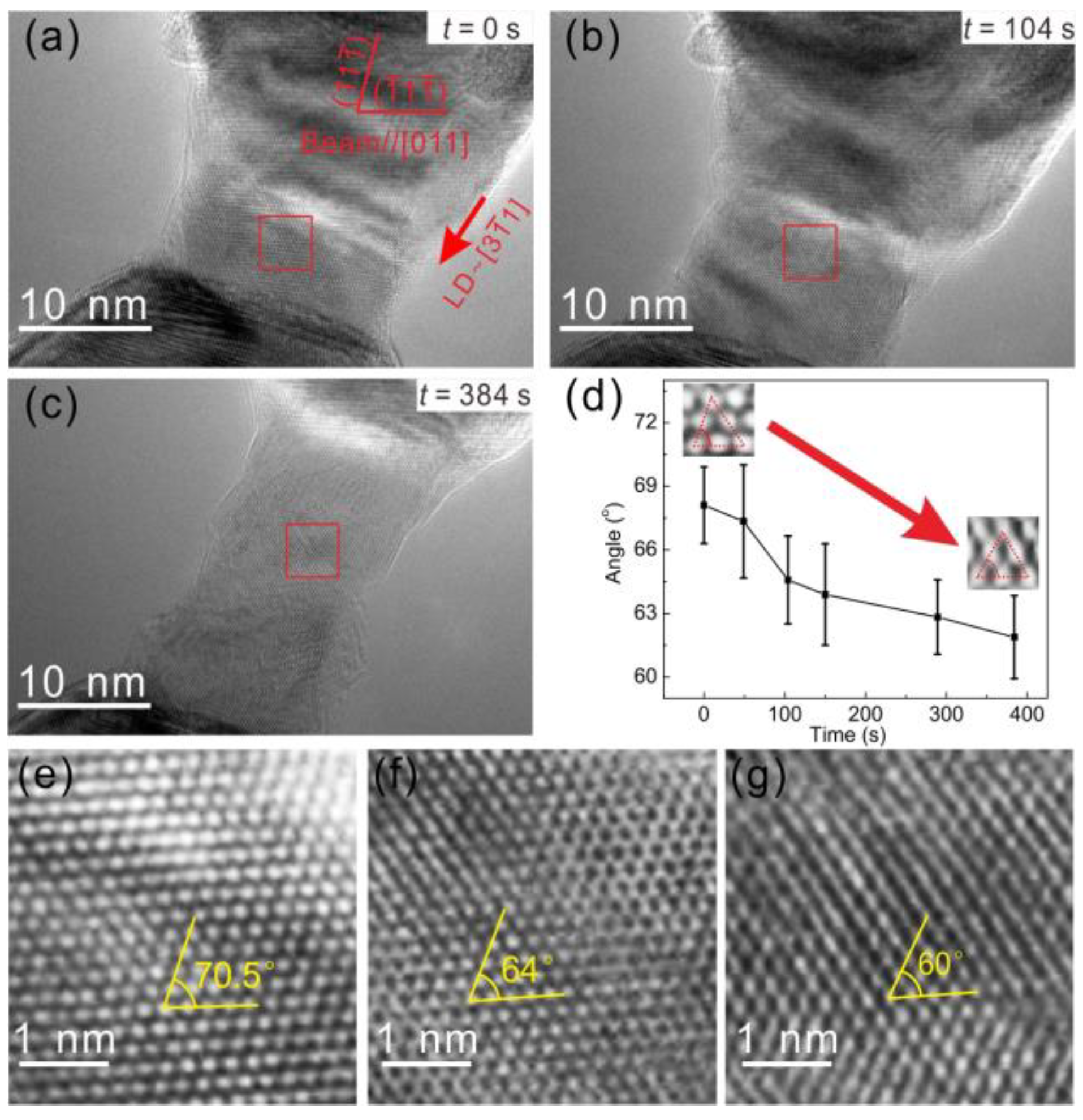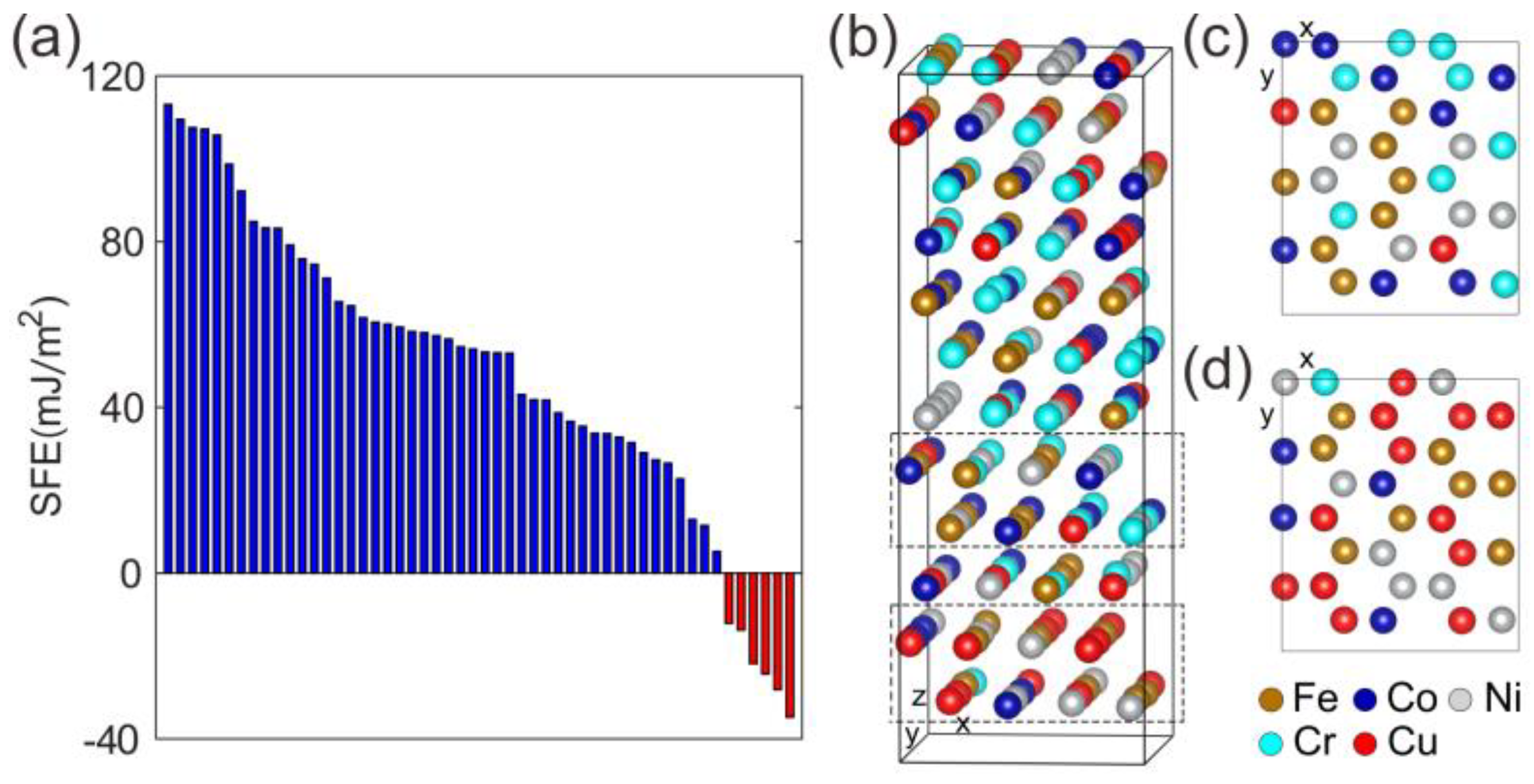Unconventional Deformation Behaviours of Nanoscaled High-Entropy Alloys
Abstract
:1. Introduction
2. Materials and Methods
3. Results
3.1. Nanodisturbances
3.2. Phase Transformation
3.3. Fluctuation of Stacking Fault Energy
4. Discussion
5. Conclusions
Supplementary Materials
Author Contributions
Funding
Conflicts of Interest
Appendix A. Theoretical Estimation of the Effects of Electron Irradiation
References
- Yeh, J.W.; Chen, S.K.; Lin, S.J.; Gan, J.Y.; Chin, T.S.; Shun, T.T.; Tsau, C.H.; Chang, S.Y. Nanostructured high-entropy alloys with multiple principal elements: Novel alloy design concepts and outcomes. Adv. Eng. Mater. 2004, 6, 299–303. [Google Scholar] [CrossRef]
- Zhang, Y.; Zuo, T.T.; Tang, Z.; Gao, M.C.; Dahmen, K.A.; Liaw, P.K.; Lu, Z.P. Microstructures and properties of high-entropy alloys. Prog. Mater. Sci. 2014, 61, 1–93. [Google Scholar] [CrossRef]
- Gludovatz, B.; Hohenwarter, A.; Catoor, D.; Chang, E.H.; George, E.P.; Ritchie, R.O. A fracture-resistant high-entropy alloy for cryogenic applications. Science 2014, 345, 1153–1158. [Google Scholar] [CrossRef] [PubMed] [Green Version]
- He, J.Y.; Wang, H.; Wu, Y.; Liu, X.J.; Nieh, T.G.; Lu, Z.P. High-temperature plastic flow of a precipitation-hardened FeCoNiCr high entropy alloy. Mater. Sci. Eng. A 2017, 686, 34–40. [Google Scholar] [CrossRef]
- Liu, J.B.; Chen, C.X.; Xu, Y.Q.; Wu, S.W.; Wang, G.; Wang, H.T.; Fang, Y.T.; Meng, L. Deformation twinning behaviors of the low stacking fault energy high-entropy alloy: An in-situ TEM study. Scr. Mater. 2017, 137, 9–12. [Google Scholar] [CrossRef]
- Wang, P.; Xu, S.; Liu, J.; Li, X.; Wei, Y.; Wang, H.; Gao, H.; Yang, W. Atomistic simulation for deforming complex alloys with application toward TWIP steel and associated physical insights. J. Mech. Phys. Solids 2017, 98, 290–308. [Google Scholar] [CrossRef] [Green Version]
- Wang, P.; Wu, Y.; Liu, J.; Wang, H. Impacts of atomic scale lattice distortion on dislocation activity in high-entropy alloys. Extrem. Mech. Lett. 2017, 17, 38–42. [Google Scholar] [CrossRef]
- Shan, Z.W.; Mishra, R.K.; Asif, S.A.S.; Warren, O.L.; Minor, A.M. Mechanical annealing and source-limited deformation in submicrometre-diameter Ni crystals. Nat. Mater. 2008, 7, 115–119. [Google Scholar] [CrossRef] [PubMed]
- Kiener, D.; Minor, A.M. Source truncation and exhaustion: Insights from quantitative in situ tem tensile testing. Nano Lett. 2011, 11, 3816–3820. [Google Scholar] [CrossRef] [PubMed]
- Uchic, M.D.; Dimiduk, D.M.; Florando, J.N.; Nix, W.D. Sample dimensions influence strength and crystal plasticity. Science 2004, 305, 986–989. [Google Scholar] [CrossRef] [PubMed]
- Zhu, T.; Li, J. Ultra-strength materials. Prog. Mater. Sci. 2010, 55, 710–757. [Google Scholar] [CrossRef]
- Wang, J.W.; Zeng, Z.; Weinberger, C.R.; Zhang, Z.; Zhu, T.; Mao, S.X. In situ atomic-scale observation of twinning-dominated deformation in nanoscale body-centred cubic tungsten. Nat. Mater. 2015, 14, 594–600. [Google Scholar] [CrossRef] [PubMed]
- Wang, J.W.; Narayanan, S.; Huang, J.Y.; Zhang, Z.; Zhu, T.; Mao, S.X. Atomic-scale dynamic process of deformation-induced stacking fault tetrahedra in gold nanocrystals. Nat. Commun. 2013, 4, 2340. [Google Scholar] [CrossRef] [PubMed] [Green Version]
- Zheng, H.; Cao, A.J.; Weinberger, C.R.; Huang, J.Y.; Du, K.; Wang, J.B.; Ma, Y.Y.; Xia, Y.N.; Mao, S.X. Discrete plasticity in sub-10-nm-sized gold crystals. Nat. Commun. 2010, 1, 144. [Google Scholar] [CrossRef] [PubMed] [Green Version]
- Sun, J.; He, L.B.; Lo, Y.C.; Xu, T.; Bi, H.C.; Sun, L.T.; Zhang, Z.; Mao, S.X.; Li, J. Liquid-like pseudoelasticity of sub-10-nm crystalline silver particles. Nat. Mater. 2014, 13, 1007–1012. [Google Scholar] [CrossRef] [PubMed]
- Lu, Y.; Song, J.; Huang, J.Y.; Lou, J. Surface dislocation nucleation mediated deformation and ultrahigh strength in sub-10-nm gold nanowires. Nano Res. 2011, 4, 1261–1267. [Google Scholar] [CrossRef]
- Wang, J.W.; Sansoz, F.; Huang, J.Y.; Liu, Y.; Sun, S.H.; Zhang, Z.; Mao, S.X. Near-ideal theoretical strength in gold nanowires containing angstrom scale twins. Nat. Commun. 2013, 4, 1742. [Google Scholar] [CrossRef] [PubMed] [Green Version]
- Guo, S.; Ng, C.; Wang, Z.; Liu, C.T. Solid solutioning in equiatomic alloys: Limit set by topological instability. J. Alloys Compd. 2014, 583, 410–413. [Google Scholar] [CrossRef]
- Gutkin, M.Y.; Ishizaki, T.; Kuramoto, S.; Ovid’ko, I.A. Nanodisturbances in deformed Gum Metal. Acta Mater. 2006, 54, 2489–2499. [Google Scholar] [CrossRef]
- Wu, Z.; Bei, H.; Pharr, G.M.; George, E.P. Temperature dependence of the mechanical properties of equiatomic solid solution alloys with face-centered cubic crystal structures. Acta Mater. 2014, 81, 428–441. [Google Scholar] [CrossRef]
- Wang, Z.; Baker, I.; Cai, Z.; Chen, S.; Poplawsky, J.D.; Guo, W. The effect of interstitial carbon on the mechanical properties and dislocation substructure evolution in Fe40.4Ni11.3Mn34.8Al7.5Cr6 high entropy alloys. Acta Mater. 2016, 120, 228–239. [Google Scholar] [CrossRef]
- Liu, S.Y.; Wei, Y.J. The Gaussian distribution of lattice size and atomic level heterogeneity in high entropy alloys. Extrem. Mech. Lett. 2017, 11, 84–88. [Google Scholar] [CrossRef]
- Nagase, T.; Rack, P.D.; Noh, J.H.; Egami, T. In-situ TEM observation of structural changes in nano-crystalline CoCrCuFeNi multicomponent high-entropy alloy (HEA) under fast electron irradiation by high voltage electron microscopy (HVEM). Intermetallics 2015, 59, 32–42. [Google Scholar] [CrossRef] [Green Version]
- Cui, J.P.; Hao, Y.L.; Li, S.J.; Sui, M.L.; Li, D.X.; Yang, R. Reversible movement of homogenously nucleated dislocations in aβ-titanium alloy. Phys. Rev. Lett. 2009, 102, 045503. [Google Scholar] [CrossRef] [PubMed]
- Bobylev, S.V.; Ovid’ko, I.A. Nanodisturbances in deformed nanowires. Phys. Rev. Lett. 2009, 103, 135501. [Google Scholar] [CrossRef] [PubMed]
- Bobylev, S.V.; Ovid’ko, I.A. Nanodisturbances and nanoscale deformation twins in fcc nanowires. Phys. Rev. B 2011, 83, 054111. [Google Scholar] [CrossRef]
- Zhang, L.J.; Fan, J.T.; Liu, D.J.; Zhang, M.D.; Yu, P.F.; Jing, Q.; Ma, M.Z.; Liaw, P.K.; Li, G.; Liu, R.P. The microstructural evolution and hardness of the equiatomic CoCrCuFeNi high-entropy alloy in the semi-solid state. J. Alloys Compd. 2018, 745, 75–83. [Google Scholar] [CrossRef]
- Nie, A.; Wang, H. Deformation-mediated phase transformation in gold nano-junction. Mater. Lett. 2011, 65, 3380–3383. [Google Scholar] [CrossRef]
- Fisher, S.B. On the temperature rise in electron irradiated foils. Radiat. Eff. 1970, 5, 239–243. [Google Scholar] [CrossRef]
- Jenčič, I.; Bench, M.W.; Robertson, I.M.; Kirk, M.A. Electron-beam-induced crystallization of isolated amorphous regions in Si, Ge, GaP, and GaAs. J. Appl. Phys. 1995, 78, 974–982. [Google Scholar] [CrossRef]



© 2018 by the authors. Licensee MDPI, Basel, Switzerland. This article is an open access article distributed under the terms and conditions of the Creative Commons Attribution (CC BY) license (http://creativecommons.org/licenses/by/4.0/).
Share and Cite
Bu, Y.; Peng, S.; Wu, S.; Wei, Y.; Wang, G.; Liu, J.; Wang, H. Unconventional Deformation Behaviours of Nanoscaled High-Entropy Alloys. Entropy 2018, 20, 778. https://doi.org/10.3390/e20100778
Bu Y, Peng S, Wu S, Wei Y, Wang G, Liu J, Wang H. Unconventional Deformation Behaviours of Nanoscaled High-Entropy Alloys. Entropy. 2018; 20(10):778. https://doi.org/10.3390/e20100778
Chicago/Turabian StyleBu, Yeqiang, Shenyou Peng, Shiwei Wu, Yujie Wei, Gang Wang, Jiabin Liu, and Hongtao Wang. 2018. "Unconventional Deformation Behaviours of Nanoscaled High-Entropy Alloys" Entropy 20, no. 10: 778. https://doi.org/10.3390/e20100778
APA StyleBu, Y., Peng, S., Wu, S., Wei, Y., Wang, G., Liu, J., & Wang, H. (2018). Unconventional Deformation Behaviours of Nanoscaled High-Entropy Alloys. Entropy, 20(10), 778. https://doi.org/10.3390/e20100778



